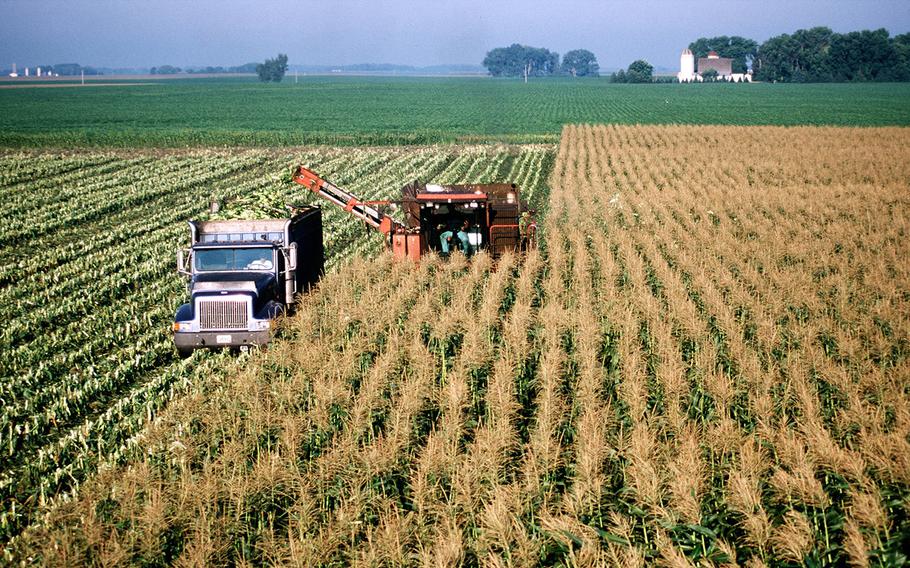
In a 2002 file image, corn is harvested on a large commercial farm near Hector, Minnesota. (Bob Fila/Chicago Tribune/TNS)
To cut greenhouse gas emissions from airplanes, the Biden administration issued guidelines this week that could shape U.S. farming for decades by offering corn growers tax credits to turn their crop into jet fuel.
To qualify, farmers would have to do three things on the land where they grow the corn: plant cover crops, avoid tilling the soil and use “enhanced efficiency” nitrogen fertilizers. Those could be relatively difficult hurdles for some farmers, such as those in Minnesota, where cover crops are rarely grown.
Minnesota’s corn farmers had hoped for easier access to the tax credits, and said they will push back against the requirements. Environmental groups and some scientists, meanwhile, said the incentives may only cement corn’s dominance on the landscape and encourage the destructive plowing of more grasslands, woodlands and marginal farm land to grow it.
The Biden administration wants the U.S. to produce 3 billion gallons of airline fuel a year from biofuels that are created from any kind of crop or biomass that emits at least 50% fewer emissions than traditional jet fuel. The 2022 Inflation Reduction Act promised producers of those crops a tax credit of between $1.25 to $1.75 per gallon, a potential windfall for Minnesota’s corn growers.
But the law wasn’t clear about whether corn-based ethanol would qualify. It left it up to federal agencies to analyze whether the totality of emissions created by turning corn into “sustainable aviation fuel,” which requires extensive amounts of land, water and fertilizer, could meet the 50% reduction threshold.
Under the new guidelines, corn growers would qualify so long as they adopted the “bundle” of all three land practices.
The incentives are an important stepping stone that acknowledge “the important role farmers can play in lowering greenhouse gas emissions,” U.S. Secretary of Agriculture Tom Vilsack said in a statement. “This is a great beginning as we develop new markets for sustainable aviation fuel that use home grown agricultural crops produced using climate smart agricultural practices.”
Corn growers from around the Midwest had hoped to find a new end-user for ethanol processed from their row crops, amid fears that as more electric vehicles and hybrid cars are put on the road demand for ethanol gasoline will fall. Air travel could provide an almost insatiable demand for the corn-based fuel for the foreseeable future. Airplanes are responsible for about 2% of the country’s greenhouse gas emissions.
Ethanol lobbyists praised the administration for keeping intact the industry’s preferred model to calculate the life-cycle emissions of corn-ethanol. But corn growers said they will push back against the cover crop and no-till requirements. In 2022 cover crops were planted on only 3% of Minnesota’s croplands, according to the U.S. Department of Agriculture.
Minnesota Corn Growers Association President Dana Allen-Tully, a southeastern Minnesota farmer, said requiring those practices for the tax credit is “unreasonable.”
“It’s especially unfortunate because there is a suite of science-backed climate smart agriculture practices farmers can implement that can achieve the same outcomes as the prescriptive approach outlined by the administration,” she said.
U.S. Rep. Angie Craig, a suburban Democrat who also represents a large swath of southern Minnesota farm country and sits on the House Agriculture Committee, slammed the White House’s announcement.
“This announcement will significantly hinder farmers and producers’ ability to participate in the (aviation fuel) market,” she said in a statement.
The tax credits will do little to actually make a dent in greenhouse gas emissions and will likely only make them worse, said Jason Hill, a professor and biofuels expert at the University of Minnesota.
Hill said the science is still out on whether cover crops or adopting no-till practices do anything to reduce emissions. If those practices do help, any benefits would be marginal compared to the carbon cost of plowing grasslands or uprooting perennial crops to grow corn.
“This provides yet another revenue stream to corn production, another giveaway to farmers and the agricultural industry at a significant cost to taxpayers and to the environment,” Hill said. “We already grow an awful lot of corn. This will likely encourage further expansion of corn acreage and the intensity of corn production. And it doesn’t do a whole lot to improve the footprint of corn.”
There is both promise and danger to the Biden administration’s strategy, said Trevor Russell, water program director for water quality advocacy group Friends of the Mississippi River.
Ethanol could cut emissions in skies and serve as a bridge until a market can be developed to grow biofuels made from perennial crops that are less harmful than corn, he said.
“But the downside is this could come at the expense of a significant increase in row crop acres,” he said. “The big question is how do we avoid those landscape conversions?”
Federal mandates requiring gasoline to be blended with ethanol has poured money into rural Minnesota for decades, offering a steady and guaranteed market for corn.
“Ethanol has been a way for farmers to take control of their own destiny a little bit,” said Brigid Tuck, a senior economic impact analyst with the University of Minnesota Extension. “Ethanol plants are (often) farmer-owned. They get a share of the profits above and beyond the sale of their corn.”
According to research from Tuck, which was sponsored by the biofuels industry and the University of Minnesota, ethanol in Minnesota produced $6.6 billion in sales last year. Sales of E15 also hit a new record in Minnesota in 2023.
©2024 StarTribune.
Visit at startribune.com
Distributed by Tribune Content Agency, LLC.